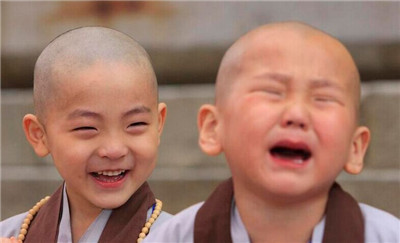赵朴初答:请谈一谈关于僧人剃发的问题。(汉英对照)

【中文版】
问:请谈一谈关于僧人剃发的问题。
赵朴初答:
根据佛制,剃发、染衣、受戒是取得僧人资格的必要条件。剃发染衣的用意是为了舍弃美好装饰,实行朴素无华的生活。一般出家人也不留胡须,但我国有一部分僧人留须,他们认为出家时应剃须,此后可以留。南方国家的僧人则一律不留须。至于受戒并不需要在头顶上烧戒疤。除汉族外,其他民族僧人都没有烧戒疤的规矩。这可能与《梵网经菩萨戒本》燃身供养之说有关。
唐朝已有炼顶(以艾燃顶)的习俗,这个习俗形成普遍的制度,据说是在元代。当时异族统治者想借以识别真假,防止抗拒法令的人民逃到僧众里面去。这话尚待查考。
【英文版】
Q:
What about the practice of tonsure for Buddhist monks?
A:
According to Buddhist regulations, a shaved head, dyed garments, and ordination are the prerequisites for gaining the monkhood. The purpose of the tonsure and dyeing of garments is to signify giving up beautification and leading a frugal and austere life. The monks generally do not wear beards, excepting some monks in China who shave their beards upon ordination, but believe that beards can be kept afterwards. No monks in southern countries grow beards. Regarding burning dot-scars on the top of head at the time of ordination, the monastics of other nationalities do not have such regulations, it is only the Han monks who do. This tradition may be related with Brahmajdla Sutta—Bodhisatta Sila which mentions burning one's own body (or parts of body) in dedication to the Buddha.
In the Tang Dynasty there was already a custom of scarring the top of the head with moxa cone. This was said to have become common practice during the Yuan Dynasty, when the alien rulers tried to distinguish the false monastics from the genuine ones in an attempt to prevent the law-breaking people from fleeing into the Sangha. This explanation remains to be verified.
- 持大悲咒有何禁忌?
- 精进念佛后家庭和事业为何会出现很多逆缘?
- 玄若法师答:为什么夜里持大悲咒会害怕?
- 元音老人:成佛的诀窍
- 楞严经大致是在说什么?如何修楞严法门?
- 不孝有三是哪三个?不孝有三的含义是什么?
- 大悲咒问答
- 印光大师问答
- 佛咒问答
- 在夫妻卧室睡着后念佛,有罪吗?
- 大安法师:家中佛堂的佛像应如何摆放?
- 在家居士能看楞严经或法华经吗?晚上能念地藏经吗?
- 地藏经问答
- 妙量法师答:大悲咒当手机铃声如法吗?
- 心经问答
- 大安法师问答
- 心里整天默诵楞严咒,方式对不对?
- 楞严咒问答
- 帕奥禅师答:天生有阴阳眼的人是否前生曾修行禅法?
- 南怀瑾问答
- 明一法师答:晚上能不能上香?为什么拜佛会哭?这是流泪佛?
- 星云大师问答
- 诵一部地藏经能一起回向给在世去世的亲人吗?
- 念佛后,孩子的成绩反而下降,是怎么回事?
- 金刚经问答
- 旧财神像可以随便丢掉吗?该怎么处理?
- 养纯白的猫是不是不吉祥?
- 佛前供水时需要打开供水杯的盖子吗?
- 因果问答
- 念佛问答
- 念大悲咒后感到胸中一朵莲花盛开,这种感应好吗?
- 阿弥陀佛像可以佩戴吗?有什么禁忌和需要注意的吗?
- 星云法师答:运气不好时如何转运?
- 良因法师答:散念《心经》将近一年,改念《地藏经》可以吗?
- 念完阿弥陀佛圣号后,是否需要回向?
- 怎么判断人死后是否去了西方?去极乐世界有何标准?
- 印光大师:如何得金刚经的真实利益?
- 给老父母、丈夫等念《金刚经》、《心经》、往生咒可以吗?
- 大安法师答:家中爬虫成灾怎么办?
- 元音老人答:《金刚经》说:‘无人相,无我相’。谁说谁闻?
- 回向给阿耨多罗三藐三菩提是什么意思?
- 念诵观世音菩萨圣号时如何观想?用观想菩萨形象吗?
- 佛教为什么有这么多法门,有区别吗?
- 看恐怖电影时,明知所演皆是幻相,为何还是恐惧?
- “上报四重恩”的“重”怎么读?
- 违五戒不杀生的愿,是不是破了不杀戒、不妄语二戒?
- 安乐八法的正命跟八正道的正命,是不一样的吗?
- 信愿念佛是专修,怎样持咒念经?
- 来生生到佛前是什么意思?
- 戒体是不持续的吗?
- 如果一切法由心想生,那外境也是自己的心想出的吗?
- 念佛号有没有方向?
- 菩萨戒从善知识获得,需要反复在佛像前自受吗?为什么?
- 佛教的正命是什么意思,如何理解?
- 念佛修行到什么程度才可以往生?往生的条件是什么?
- 往生西方必须要一心不乱,发菩提心才能往生吗?
- 如何看待善知识,要如何依止世间的善知识?
- 往生一定要培植甚深的善根、积累广大的福德吗?
- 学佛人可以化妆吗,学佛后化妆打扮是否如法?
- 发不起度众生的菩提心,只想先往生,这样能往生吗?
- 佛菩萨圣诞时,在家供佛需像寺院一样按仪轨做吗?
- 何者是“心”?是六识吗?如何定义、理解和界定?
- 在特殊佛教日做供养,功德有差别吗?
- 为什么抛妻弃子的男人不遭报应,反而过得很好?
- 可以重复受戒吗?
- 学佛学偏了,是因为没有真的深信吗?
- 受五戒后犯了不饮酒戒和不邪淫戒,该怎么办?
- 什么是“仰信” 、“通身靠倒”、 “作得生想”,如何运用到念佛中?
- 如何可以让愿力大过业力?
- 在家居士是可以自己审罪还是该请师父?
- 为什么度他人容易,度自己的家人却很难?
- 小孩念佛怎样回向?要回向吗?
- 怎样让年轻人接受并欢喜听经闻法?
- 寺院为犯煞星顺星是否如法?佛弟子能否顺星?
- 为什么一念经就有很多妄想,如何对治?
- 念经过程中,可不可以有法喜?
- 为什么要知母、念恩、报恩,对众生有意义吗?
- 亲人去世后,皈依证怎么处理?
- 遇到假和尚化缘该怎么办?
- 幻化出来的众生有贪爱吗?
- [放生起源]寺院设立放生池在经典或传统上有什么根据?
- [感应故事]心经故事
- [白茶]什么是白茶,有哪些品种?
- [白茶]什么是白茶?白茶的简单介绍
- [佛与人生]面对别人的批评,应该怎么做?
- [佛学常识]八关斋戒的解释、戒相、功德利益
- [佛学常识]袈裟是什么意思?为什么叫福田衣?
- [佛学常识]为什么把佛法僧三者称为“宝”?
- [佛学常识]为什么要皈依三宝?归投三宝令身心安稳
- [人物故事]佛教贫女供灯的故事与启示
- [佛经故事]释迦牟尼佛和菩提达多的双头鸟故事
- [佛学常识]食存五观指的是什么?
- [人物故事]阿育王的小王妃须阇哆,持戒穿素服得宝珠
- [禅宗公案]老修行人“三十年不冒烟”的故事
- [佛经故事]富孩子变穷孩子,《法华经》穷子喻的故事
- [佛学常识]布施的意思与种类
- [佛经故事]伽尸比丘尼身披袈裟出生的因缘故事




